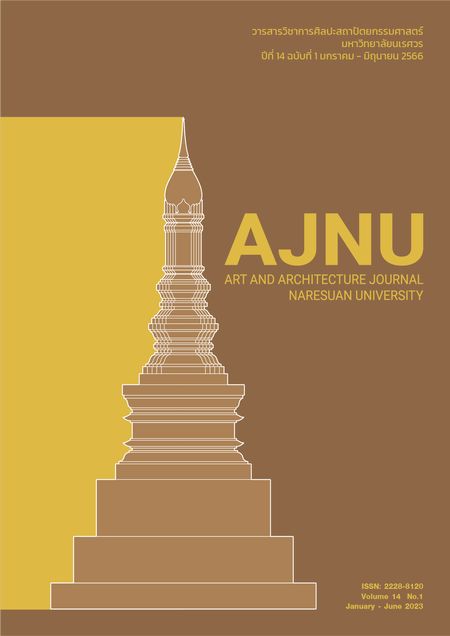Mae Chaem : Existing of Vernacular landscape in Lanna Culture.
Main Article Content
Abstract
This article is part of the thesis titled "The cultural environment and vernacular architecture of Mae Chaem under the context of change" aiming to understand the settlements in the valley area. This thesis uses the Mae Chaem district area as a study area through the study of the vernacular cultural landscape of the current Mae Chaem community to be analyzed for comparison with the cultural landscape of Lanna, culture and explain the existence and changing factors of the cultural landscape.
Results from the study reveal that the vernacular landscape of Mae Chaem district is formed by natural factors and cultural factors related to agriculture especially rice culture which can be observed from the various traditions that occurred as they correspond to the production cycle. It is also the land that has been settled for a long time. People here, therefore accumulate wisdom to learn, adapt, and adjust the environment to be suitable for staying and living by recognizing the importance of the environment by linking with the beliefs concealed with the respect to nature either" Soil, water, and forest". This results in "The Vernacular Landscape of Mae Chaem" which is a unique characteristic of the district in the valley plains under the Lanna culture which can be divided into the components of urban structure into 4 areas, namely; 1. The area of perceptual territory and relationship groups; 2.The area of spirits and holy places; 3.The area of public utility areas of the district and; 4.The living area of the community. When considering these 4 areas mentioned above, it can be concluded that in the existence of the Mae Chaem landscape, factors affecting the existence are the inheritance of vernacular culture that can still be preserved, such as traditions and rituals including maintaining social relations between different groups such as house, temples and mine groups. These allow the people in the society to remain closely connected in a manner of kinship society resulting in the learning process and wisdom that can be inherited from generation to generation which brings about the preservation of the vernacularl cultural landscape so perfectly.
Keywords : Existing, Change, Vernacular landscape, Lanna culture, Maechaem
Article Details

This work is licensed under a Creative Commons Attribution-NonCommercial-NoDerivatives 4.0 International License.
References
เกรียงไกร เกิดศิริ. (2551). ชุมชนกับภูมิทัศน์วัฒนธรรม (พิมพ์ครั้งที่ 1). กรุงเทพฯ : สำนักพิมพ์อุษาคเนย์.
เกรียงไกร เกิดศิริ. (2554). ภูมิทัศน์เมืองโบราณและองค์ประกอบของเมือง กรณีศึกษาเมืองเชียงตุงและเมืองเชียงใหม่. สืบค้นเมื่อ 15 ตุลาคม 2562. จาก http://tdc.thailis.or.th/tdc/index.php.
ฝอยทอง สมวถา (สมบัติ). (2546). เล่าขานตำนานเมืองแจ่ม. เชียงใหม่ : นพบุรีการพิมพ์.
พินัย สิริเกียรติ. (2542). เรือนล้านนาไทยในอำเภอแม่แจ่ม. รายงานสถาปัตยกรรมพื้นถิ่น ในรายวิชาสถาปัตยกรรมพื้นบ้าน คณะสถาปัตยกรรมศาสตร์ มหาวิทยาลัยศิลปากร, ภาคปลาย ปีการศึกษา 2542.
สืบพงษ์ จรรย์สืบศรี. (2557). เรือนไม้แม่แจ่ม: ลมหายใจของเฮือนบะเก๋าล้านนา. วารสารหน้าจั่ว ว่าด้วยสถาปัตยกรรม
การออกแบบ และสภาพแวดล้อม, 28, 75-99.
สืบพงษ์ จรรย์สืบศรี และคณะ. (2558). แผนที่มรดกวัฒนธรรมอำเภอแม่แจ่ม จังหวัดเชียงใหม่. วารสารหน้าจั่วว่าด้วยสถาปัตยกรรม การออกแบบและสภาพแวดล้อม, 29, 63-85.
อนุวิทย์ เจริญศุภกุล และวิวัฒน์ เตมียพันธ์. (2539). เรือนล้านนาไทยและประเพณีการปลูกเรือน (พิมพ์ครั้งที่ 2). กรุงเทพฯ: สมาคมสถาปนิกสยาม, 7-8.
อิศรา กันแตง. (2557). เมืองแม่แจ่ม: ภูมิปัญญาล้านนาในการตั้งถิ่นฐาน. วารสารหน้าจั่วว่าด้วยสถาปัตยกรรม การออกแบบ และสภาพแวดล้อม, 28, 57-74.


